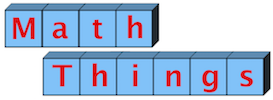The Rhombus Machine (Parallelograms too)
You can make several models of both machines from the parts in the downloadable file below. Get the shortest possible paper fasteners.
You really only need one model, but it reinforces the point of this lesson to have a rhombus, a "vertical" parallelogram, and at least one size of the "horizontal" parallelogram, which is what students usually see. A Parallelogram Machine with 4 equal sides is also helpful. In other words, you'll have 2 machines that can be formed into squares. One will be labeled a Rhombus Machine, and the other a Parallelogram Machine.
Make enough copies of these so that students can swap them back and forth and discuss what happens. No matter how they move the sides, the opposite sides remain parallel. Sometimes the parallelogram Machine is a rectangle, sometimes not, but it's always a parallelogram.
The reasoning about all this touches on ideas related to the properties of these quadrilaterals and set theory, or "a hierarchy based on properties," as CCSC 5.G.4 nicely puts it. This makes for important and fascinating discussions.
Activities intended to facilitate these discussions are included in my activity Quadrilateral Sorting, or How can a square be a rectangle?!
To make the machines, print a page of parts onto cardstock and cut them with a paper cutter. They are arranged on the page to be cut with single cuts. Use different colors if you can, but please don't "color code" them. Either use all one color, or have different colors of each model. We don't want our students thinking that all rhombi are red!
Download the Rhombus and Parallelogram Machine templates (PDF).
By the way, you can see that I am operating from the traditional definition of trapezoid as a quadrilateral with exactly one pair of parallel sides, and parallelogram as a quadrilateral with two pairs of parallel sides. Lots of discussion going on about this right now.



